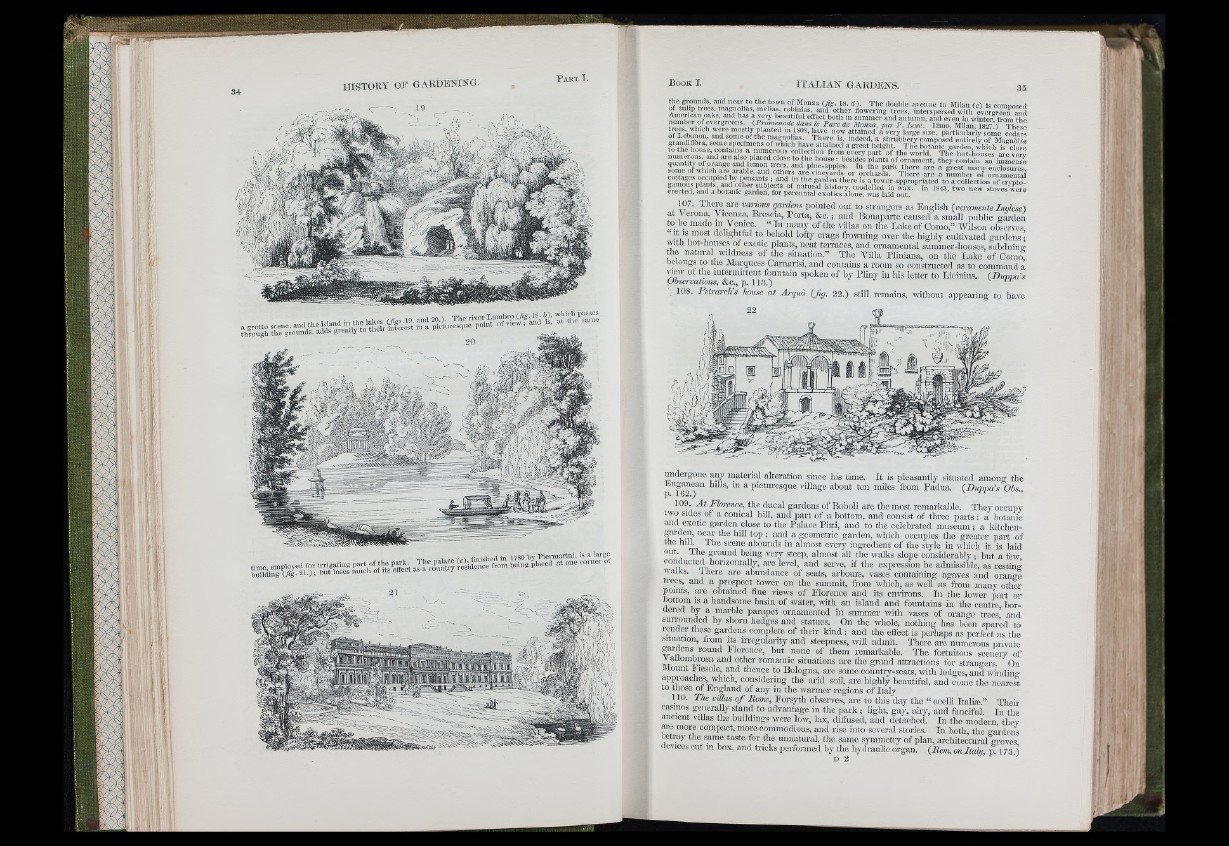
I F i
f L u ' !
■1 il
HISTORY OF GARDENING.
19
P a r t T.
f
B o o k L ITA L IA N GARDENS.
20
35
trees which were mostly planted in 1808, have now attained a very large size p ak icu lïrlv some S fr«
to the house, contains a numerous collection from every part of th e world The hoTh^^^^^^ f p v f u
s s s l l l S i i g i S i i ^
107. There are various gardens pointed out to strangers as English (veramente Inglese)
Y Verona, Vicenza, Bresciig Porta, &c. ; and Bonaparte caused a small public g i-d en
to be made m Yemce. “ In many of the villas on tho Lake of Como,” Wilson observes,
U IS most dchgbtfid to bcliold lofty crags frowning over the highly cultivated gardens ;
■v^h liot-houses of exotic plants, neat ten-aces, and ornamental snmmcr-housos, subdnine
toe natural wildness of toe situation.” The Villa Pliniana, on the Lake of Comm
f)clongs to the Mai-quess Carnîirîsi, and contciins a room so constructed as to command a
new of the intermittent fountain spoken of by Pliny in his letter to Licinius. (Duppa’s
Observations, &C.., g. lia .) s r p
108. Petrarch’s house at Arquà {fig. 22.) still remains, without appearing to have
undergone any materia.1 alteration since his time. It is pleasantly situated among the
p Tg2 )^” ^ picturesque village about ten miles from Padua. {Duppa’s Obs.,
109. A t Florence, the ducal gardens of Boboli are themost remarkable. They occupy
two sides of a conical hill, and part of a bottom, and consist of three pai'ts : a botanic
and exotic garden close to the Palace Pitti, and to the celebrated museum; a kitchen-
?i’ ^ geometric garden, which occupies the gi-eatcr part of
the hiJk The scene ^abounds in almost every ingredient of the style in which it is laid
out. The ground being very steep, almost all the walks slope considerably; but a few
are level, and serve, if the expression be admissible, as resting
walks. There are abundance of seats, arbours, vases containing agaves and orange
trees, and a prospect tower on the smnmit, from which, as well as from many other
points, are obtained fine views of Florence and its environs. In the lower part or
bottom is a handsome basin of water, with an island and fountains in the centre bordered
by a marble parapet ornamented in summer with vases of orane-e trees’ and
sun-ounded by shorn hedges and statues. On the whole, notliing has been spai-’ed to
lender these gardens complete of their kind : and the effect is perhaps as perfect as the
situation, from fts UTcgularity and steepness, will admit. There me numerous private
gardens round Florence, but none of them remarkable. Tbe fortuitous sconcrv of
vauombrosa and other romantic situations arc the grand attractions for strangers. On
Mount Fiesole, and thence to Bologna, arc some country-seats, with lodges, and windiiiE-
approaches, which, considering toe arid soil, are highly beautiful, and come the nearest
to tliose ot England of any in the warmer regions of Italy
110. The viU^ o f Rome, Forsyth observes, are to this day the “ ocelh Italiic.” Their
casinos generally stand to advantage in the p a r k ; light, gay, airy, and fanciful. In the
ancient \iUas the buildings were low, lax, diffused, and detached. In the modern they
arc more compact, more commodious, and rise into several stories. In both, the gardens
Ijctray the same taste for the unnatural, the same symmetry of plan, architectural aroves
devices cut m box, and tricks performed by the hydraulic organ. {Rem. on Italy, p. ] 73.)
1 1 |,
■f ! .